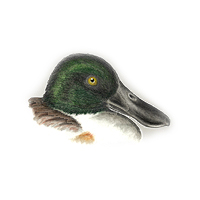|
Field
Guide IDs: BREEDING:
Freshwater
shallows, esp muddy, sluggish habitats and
surrounding marsh veg; also wet, prairie meadows. 1
brood. DISPLAYS:
See:
Duck
Displays. NEST:
Usu in short grass
on boggy edge of water, occ in field, meadow, or
emergent veg. Concealed depression filled with dry
grass, other veg. Lined with down as incubation
advances. EGGS:
EGGS:
Olive-buff/greenish-gray. 2.0" (52 mm). DIET:
Aquatic veg, esp
plankton; snails, clams, aquatic insects. Feeds
primarily by straining small plants and animals
from water's surface through comblike edge of bill;
also feeds along mudflat margins. CONSERVATION:
Winters s to n
S.A. NOTES:
Females incubate
more sporadically than other ducks, spend more time
foraging. Some males remain paired and stay on
territories throughout incubation. Often nests
late, esp in n. Uncommon to fairly
common winter visitor at Lagunita, usually seen
foraging in shallows at the edge of the
lake. ESSAYS: Metallic
Poisons;
Dabblers
vs. Divers;
Commensal
Feeding;
Incubation
Time;
Breeding
Season;
Feathered
Nests. REFERENCES:
Afton, 1979a, b;
Bellrose, 1976; Gooders and Boyer, 1986. |
